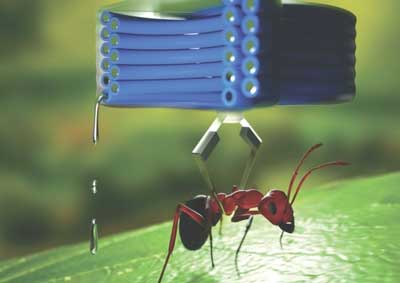| May 21, 2018 |
Soft machines
|
|
(Nanowerk News) In the world of robotics, soft robots are the new kids on the block. The unique capabilities of these automata are to bend, deform, stretch, twist or squeeze in all the ways that conventional rigid robots cannot.
|
|
Today, it is easy to envision a world in which humans and robots collaborate -- in close proximity -- in many realms. Emerging soft robots may help to ensure that this can be done safely, and in a way that syncs to human environments or even interfaces with humans themselves.
|
|
"Some of the advantages of soft robotic systems are that they can easily adapt to unstructured environments, or to irregular or soft surfaces, such as the human body," said UC Santa Barbara electrical and computer engineering professor Yon Visell.
|
|
Despite their promise, to date, most soft robots move slowly and clumsily when compared with many conventional robots. However, the gap is narrowing thanks to new developments in the fundamental unit of robotic motion: the actuator. Responsible for the mechanical movement of a mechanism or a machine, actuators do their work in various ways, relying on electromagnetic, piezoelectric, pneumatic or other forces.
|
|
Now, Visell and his UCSB collaborators have married the electromagnetic drives used in most conventional robotic systems with soft materials, in order to achieve both speed and softness. "An interesting biological analog to the actuator described in our new work might be a fast twitch muscle," said Visell, who along with UCSB chemistry and biochemistry professor Thuc-Quyen Nguyen, and postdocs Thanh Nho Do and Hung Phan, authored a paper that appears on the cover of the journal Advanced Functional Materials ("Soft Electromagnetic Actuators: Miniature Soft Electromagnetic Actuators for Robotic Applications").
|
 |
| A small, soft actuator made of liquid metals and flexible polymers is the soft analog of an electromagnetic motor. (Image: UCSB)
|
|
The main challenge for Visell and colleagues was to build an actuator that could achieve speeds greater than what has typically been possible with soft robotic actuators, many of which depend on slow processes, such as air flow or thermal effects.
|
|
"In this project, we wanted to see how far we could push the idea of having very fast, low-voltage actuation within a fully soft robotic paradigm," he said. They based their work on the electromagnetic motor, a common type of fast and low-voltage actuator that is used in everything from electric cars to appliances, but has seen little effective application in soft robotic systems.
|
|
The team's work has resulted in a type of actuator that is fast, low voltage and soft -- and also remarkably small, just a few millimeters in size. Using unique, liquid-metal alloy conductors encased in hollow polymer fibers and magnetized polymer composites, the researchers created patterned, three-dimensional components that form the basis of soft analogs of standard electrical motors. The fibers themselves are polymer composites that the team engineered to have high thermal conductivity, greatly improving their performance.
|
|
"We realized components that are each soft and stretchable, and combined them to create these motor-like structures that can move things," Visell said. To demonstrate, they created a tiny, millimeters-wide gripper that can close in just milliseconds, and a soft tactile stimulator that can operate at frequencies of hundreds of cycles per second.
|
|
These devices could find use in emerging areas such as haptics, where touch feedback is sought for applications including virtual reality and, of course haptics' close relative -- soft robotics. "These soft electromagnetic actuators can be used to create tactile displays that conform to human skin, or miniature robotic tools for surgical endoscopy or other medical applications," said postdoc Thanh Nho Do.
|
|
"We look forward to applying these new soft robotic technologies in areas ranging from virtual reality, augmented reality, wearable technologies, healthcare and medicine," Visell said. "The horizon is wide open."
|

